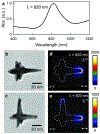Light-Mediated Directed Placement of Different DNA Sequences on Single Gold Nanoparticles
- PMID: 33661606
- PMCID: PMC9210506
- DOI: 10.1021/jacs.0c11699
Light-Mediated Directed Placement of Different DNA Sequences on Single Gold Nanoparticles
Abstract
This paper describes the light-directed functionalization of anisotropic gold nanoparticles with different thiolated-DNA oligomer (oligo) sequences. The starting nanoconstructs are gold nanostars (AuNS) uniformly grafted with one oligo sequence that are then exposed to fs-laser pulses at the plasmon resonance of the branches. The excitation selectively cleaves Au-S bonds at the tips of the branches to create vacant areas for functionalization with a different thiolated oligo sequence. Nanoconstructs synthesized by this approach present one oligo sequence on the AuNS body and branches and a different sequence at the tips. This process enables the formation of nanoparticle superstructures consisting of AuNS cores and small Au satellite nanoparticles at controlled locations after DNA hybridization. Our strategy enables selective oligo presentation at the single-particle level and opens prospects for sophisticated design of nanoscale assemblies that are important in a wide range of biological applications.
Conflict of interest statement
The authors declare no competing financial interest.
Figures





References
-
- De Silva Indrasekara AS; Norton SJ; Geitner NK; Crawford BM; Wiesner MR; Vo-Dinh T, Tailoring the Core–Satellite Nanoassembly Architectures by Tuning Internanoparticle Electrostatic Interactions. Langmuir 2018, 34 (48), 14617–14623. - PubMed
-
- Ha M; Kim J-H; You M; Li Q; Fan C; Nam J-M, Multicomponent Plasmonic Nanoparticles: From Heterostructured Nanoparticles to Colloidal Composite Nanostructures. Chemical reviews 2019, 119 (24), 12208–12278. - PubMed
-
- Mazur F; Liu L; Li H; Huang J; Chandrawati R, Core-satellite gold nanoparticle biosensors for monitoring cobalt ions in biological samples. Sensors and Actuators B: Chemical 2018, 268, 182–187.
-
- Wilhelm S; Tavares AJ; Dai Q; Ohta S; Audet J; Dvorak HF; Chan WCW, Analysis of nanoparticle delivery to tumours. Nature Reviews Materials 2016, 1 (5), 16014.
Publication types
MeSH terms
Substances
Grants and funding
LinkOut - more resources
Full Text Sources
Other Literature Sources

